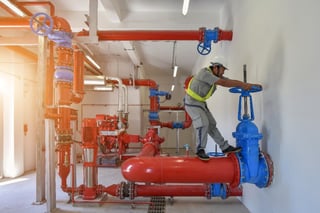[No use]Corrosion Management Technology: Fire Sprinkler System Vent

These days one does not have to search hard to find an advertisement or product feature on automatic air vents for fire sprinkler systems. It feels like the sprinkler industry has been inundated with a new vent product from a different manufacturer every few months. This might lead some to believe automatic air vents have only been used in fire sprinkler systems for the past few years. The truth is ECS engineers designed the first automatic air vent for use in fire sprinkler systems over 15 years ago.
While a lot has changed within our industry over the past 15 years, the fundamental function and benefit of an automatic air vent remains the same. The device is designed to remove excess trapped air (which contains 21% corrosive oxygen gas) from the fire sprinkler system to reduce corrosion activity. The relationship between corrosion and trapped air in wet pipe sprinkler systems is directly proportional. For example, if 50% of trapped air can be removed from a single air vent it results in a 50% reduction of corrosion activity.
It wasn’t until the 2016 edition of NFPA 13 (sections 7.1.5 and 8.16.6) required a means of venting trapped air from all new wet pipe sprinkler systems that automatic air vents became a popular topic amongst fire sprinkler system designers and installers.
As of the writing of this post there are currently eight (8) U.S. states that have adopted the 2016 edition of NFPA 13 (e.g. California, Maryland, and Ohio) and there are plans for at least seven (7) more states to adopt the newer edition sometime in 2020 (e.g. Florida, Illinois, and New York). This does not include another dozen large municipalities that have adopted the 2016 edition despite older editions adopted at the state level (e.g. Denver, Philadelphia, and Phoenix). It would not be a stretch to presume that more than half of the United States will require a vent on new wet pipe sprinkler systems within the next 5 years.
Our Solution
While there are many options available to remove trapped air from a fire sprinkler system, the current patented design of the ECS Ejector Automatic Air Vent (PAV-W) offers several unique features that are not available on any other vent supplied to the fire sprinkler industry:
Redundant Float Valves – supplying a primary and redundant float valve in series removes the requirement to plumb the outlet of the vent to a drain; if the primary float fails, the secondary float is available to stop the flow of water
Functional Status Indicator – a high visibility gauge placed between the outlet of the primary float and the inlet of the secondary float will show system pressure in the event the primary float has failed; the indicator can be viewed from the finished floor which eliminates the need to access the vent during inspection
System Connection – a specialty high pressure quick-connect component is used in place of a union in conjunction with an isolation ball valve to allow the vent to be removed from the system for service without the need to drain the system
Nitrogen Inerting – the ECS PAV-W can be upgraded to accommodate the patented ECS Wet Pipe Nitrogen Inerting (WPNI) process for fire sprinkler systems that need a higher level of corrosion protection
ECS strongly believes that an air vent with a double float redundancy is the best option to remove trapped air in a fire sprinkler system. The built-in redundancy reduces risk for both the end user and the installing contractor. This is why we do not sell alternative options like a ball valve or a single float vent.
A ball valve provides the cheapest option to vent a fire sprinkler system, but it is also highly unlikely to substantially reduce long term corrosion activity. If the ball valve is not installed at floor level and its location is not easily identified it will not be used during future system fills after the installing contractor hands the system over to the building owner.
An automatic air vent with a single float valve presents an intermediate option that eliminates the requirement to manually operate a valve, but also presents a leak risk if it is not plumbed to a drain. Often the additional labor and material required to pipe the vent to a drain offsets the initial cost savings of a single float vent. If a single float vent is NOT plumbed to a drain, then both the installing contractor and the end user are at risk. If the vent fails and leaks water during the first year of operation the installing contractor would be responsible not only for replacing the air vent, but also for any damage caused to property as a result of the vent failure. A leak could represent equipment damage, downtime, or business disruption to the end user.
The ECS Ejector Automatic Air Vent (PAV-W) is both UL Listed and FM Approved for use in fire sprinkler systems and is the most widely used redundant air vent in the industry. The PAV-W also provides the longest track record of successful operation when compared to any other automatic venting device. ECS sells direct to fire sprinkler contractors and the PAV-W can be purchased directly from our website from the link below.
